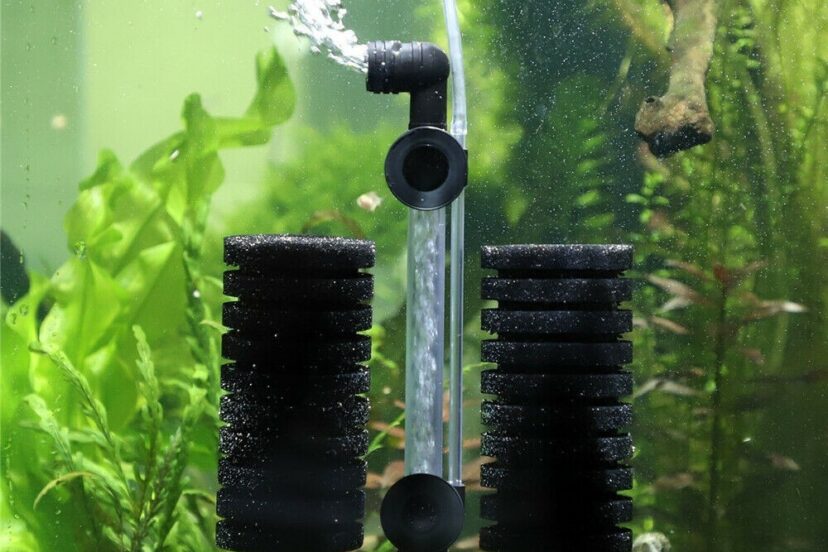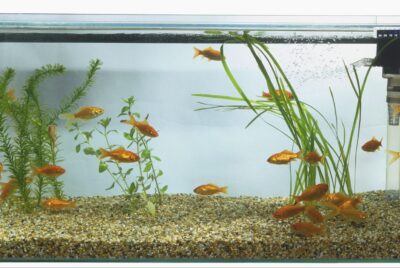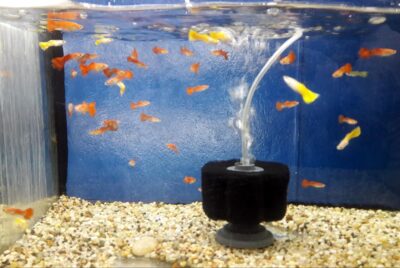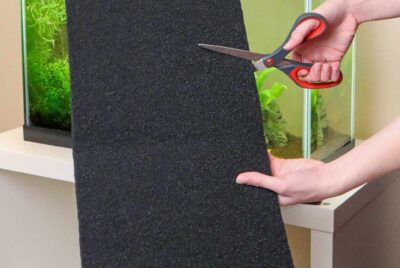How Does an Aquarium Sponge Filter Work
“How Does an Aquarium Sponge Filter Work?” As a passionate fishkeeping enthusiast, I understand the importance of maintaining a healthy and clean environment for our aquatic companions. One crucial aspect of aquarium filtration is the effective use of a sponge filter. In this article, I will guide you through the functioning of an aquarium sponge filter, its components, benefits, setup process, troubleshooting common issues, and even explore some alternatives. So, let’s dive right in and learn how this essential piece of equipment keeps our aquariums thriving.
Understanding the Function of an Aquarium Sponge Filter
Aquarium sponge filters operate on a simple yet effective principle. They provide both mechanical and biological filtration, ensuring a balanced and healthy aquatic ecosystem. Unlike traditional filters that employ cartridges or filter media, sponge filters utilize a porous sponge to trap debris and foster the growth of beneficial bacteria.
Components of an Aquarium Sponge Filter
To comprehend the inner workings of an aquarium sponge filter, let’s first look at its key components:
1. Sponge Media – (How Does an Aquarium Sponge Filter Work)
The sponge media is the heart of a sponge filter. It comes in various shapes and sizes, but the most common form is a cylindrical sponge with fine pores. The sponge acts as the primary site for biological filtration, hosting colonies of beneficial bacteria that break down harmful ammonia and nitrites.
2. Air Pump – (How Does an Aquarium Sponge Filter Work)
An aquarium sponge filter relies on an air pump to draw water through the sponge. The air pump creates a gentle suction, pulling water into the filter and driving the filtration process. It is crucial to select an air pump suitable for the size of your aquarium to ensure optimal filtration efficiency.
3. Airline Tubing – (How Does an Aquarium Sponge Filter Work)
The air pump is connected to the sponge filter via airline tubing. This flexible tube allows air to flow from the pump into the filter, creating the necessary water movement and oxygenation.
Water Filtration Process
The water filtration process in an aquarium sponge filter involves both mechanical and biological mechanisms. Let’s explore each of them in detail:
Mechanical Filtration
As water is drawn into the sponge filter, the fine pores of the sponge act as a mechanical filter, trapping debris, uneaten food, and other solid waste. This prevents the accumulation of harmful substances and maintains water clarity.
Biological Filtration
The sponge filter’s true power lies in its ability to support biological filtration. The porous structure of the sponge provides an ideal surface area for beneficial bacteria to thrive. These bacteria convert toxic ammonia and nitrites into less harmful nitrates, ensuring a safe and healthy environment for your fish.
Benefits of Using an Aquarium Sponge Filter
Using an aquarium sponge filter offers several advantages, making it a popular choice among fishkeepers. Let’s explore some of these benefits:
1. Provides Biological Filtration
The presence of beneficial bacteria in the sponge ensures the establishment of a stable biological filter. This helps maintain optimal water conditions and promotes the overall well-being of your aquatic pets.
2. Maintains Water Clarity
The mechanical filtration provided by the sponge ensures that debris and particulate matter are efficiently removed from the water column, resulting in crystal-clear water.
3. Gentle Water Flow
Unlike some other filters that create strong currents, sponge filters offer a gentle water flow. This is particularly beneficial for delicate or slow-swimming fish species, as it minimizes stress and allows them to thrive in a more natural environment.
4. Suitable for Small Tanks
Sponge filters are highly versatile and well-suited for small aquariums or breeding tanks. Their compact size and efficient filtration make them an excellent choice for maintaining water quality in confined spaces.
5. Cost-Effective Solution
Compared to other filtration systems, sponge filters are relatively inexpensive. They offer a budget-friendly option for both beginner and experienced fishkeepers, ensuring that effective filtration is accessible to all.
Setting Up an Aquarium Sponge Filter
Now that we understand the importance and benefits of using a sponge filter let’s discuss the proper setup process:
Placement – (How Does an Aquarium Sponge Filter Work)
To maximize the filtration efficiency, place the sponge filter in an area of your aquarium where water circulation is necessary. It is recommended to position it near the outlet of a water pump or in a location with poor water movement.
Assembly – (How Does an Aquarium Sponge Filter Work)
Assembling a sponge filter is straightforward. Connect the airline tubing to the air pump and attach the other end to the sponge filter’s designated connection point. Ensure a secure fit and check for any air leaks.
Proper Maintenance – (How Does an Aquarium Sponge Filter Work)
To maintain the effectiveness of your sponge filter, regular maintenance is essential. Periodically clean the sponge by gently squeezing it in a bucket of aquarium water to remove accumulated debris. Avoid using tap water or harsh chemicals, as they can harm the beneficial bacteria.
Choosing the Right Sponge Filter for Your Aquarium
When selecting a sponge filter for your aquarium, consider the following factors:
Tank Size and Capacity
Choose a sponge filter that is appropriate for the size of your aquarium. Manufacturers often provide recommendations based on tank volume or fish population.
Sponge Pore Size
Different sponge filters come with varying pore sizes. Finer pores offer better mechanical filtration, while larger pores may provide higher water flow rates. Select a sponge pore size that suits your specific needs.
Sponge Quality
Opt for high-quality sponges that are durable and won’t deteriorate quickly. Poor-quality sponges may break apart or lose their effectiveness over time.
Noise Level
Some air pumps can be noisy, which can be bothersome in quiet environments. Look for air pumps that operate quietly to ensure a peaceful atmosphere around your aquarium.
Ease of Cleaning
Consider the ease of cleaning and maintenance when choosing a sponge filter. Some filters have removable sponges, making the cleaning process more convenient.
Troubleshooting Common Issues with Sponge Filters
Despite their effectiveness, sponge filters may encounter certain issues. Let’s address some common problems and their potential solutions:
Sponge Clogging
If you notice reduced water flow or decreased filtration efficiency, your sponge might be clogged. Clean the sponge by rinsing it in aquarium water, ensuring the removal of any accumulated debris.
Insufficient Airflow
Inadequate airflow may indicate a problem with your air pump. Check the airline tubing for kinks or blockages, and ensure that the air pump is functioning correctly.
Noisy Operation
If your sponge filter or air pump produces excessive noise, consider placing them on a soft mat or foam pad to minimize vibrations. Alternatively, opt for a quieter air pump model.
Poor Water Quality
If your aquarium’s water quality deteriorates despite using a sponge filter, evaluate other factors such as overfeeding, inadequate water changes, or excessive fish population. Adjust these factors as necessary to maintain optimal water conditions.
Alternatives to Sponge Filters – (How Does an Aquarium Sponge Filter Work)
While sponge filters are highly effective for many aquarium setups, it’s worth exploring alternative filtration options based on your specific needs:
Power Filters
Power filters provide mechanical and chemical filtration, and some models offer biological filtration as well. They are suitable for larger tanks and offer adjustable flow rates and filter media customization.
Canister Filters
Canister filters are external filters that provide comprehensive filtration, including mechanical, chemical, and biological processes. They are highly efficient and suitable for larger aquariums or those housing more demanding fish species.
Hang-On-Back (HOB) Filters
HOB filters are compact and easy to install. They hang on the back of the aquarium and provide mechanical and chemical filtration. They are ideal for small to medium-sized tanks.
Conclusion – (How Does an Aquarium Sponge Filter Work)
In conclusion, an aquarium sponge filter is a valuable tool in maintaining a healthy and thriving aquatic environment. Its simple yet effective design provides both mechanical and biological filtration, keeping the water clean and promoting the well-being of your fish. By understanding its components, benefits, setup process, troubleshooting tips, and exploring alternative options, you can make an informed decision when choosing the right filtration system for your aquarium.
Frequently Asked Questions – (How Does an Aquarium Sponge Filter Work)
Q: Can I use an aquarium sponge filter in a saltwater aquarium?
A: Yes, sponge filters are suitable for both freshwater and saltwater aquariums. However, keep in mind that they primarily provide biological filtration and may not be sufficient for certain saltwater setups that require additional filtration methods.
Q: How often should I clean my sponge filter?
A: It is recommended to clean the sponge filter every 2 to 4 weeks or as needed. Regular maintenance ensures optimal filtration efficiency and prevents clogging.
Q: Can I use multiple sponge filters in one aquarium?
A: Yes, you can use multiple sponge filters in larger aquariums or tanks with high bioload. Distributing the filters evenly helps create balanced water flow and enhances filtration.
Q: Are sponge filters suitable for breeding tanks?
A: Absolutely! Sponge filters are highly beneficial in breeding tanks as they provide gentle water flow, mechanical filtration, and a safe haven for the growth of beneficial bacteria, which is crucial for the health and development of fry.
Q: Do I still need to perform water changes with a sponge filter?
A: Yes, even with a sponge filter, regular water changes are necessary to remove dissolved pollutants, replenish essential minerals, and maintain water quality. Sponge filters complement water changes by maintaining biological filtration between water change intervals.




